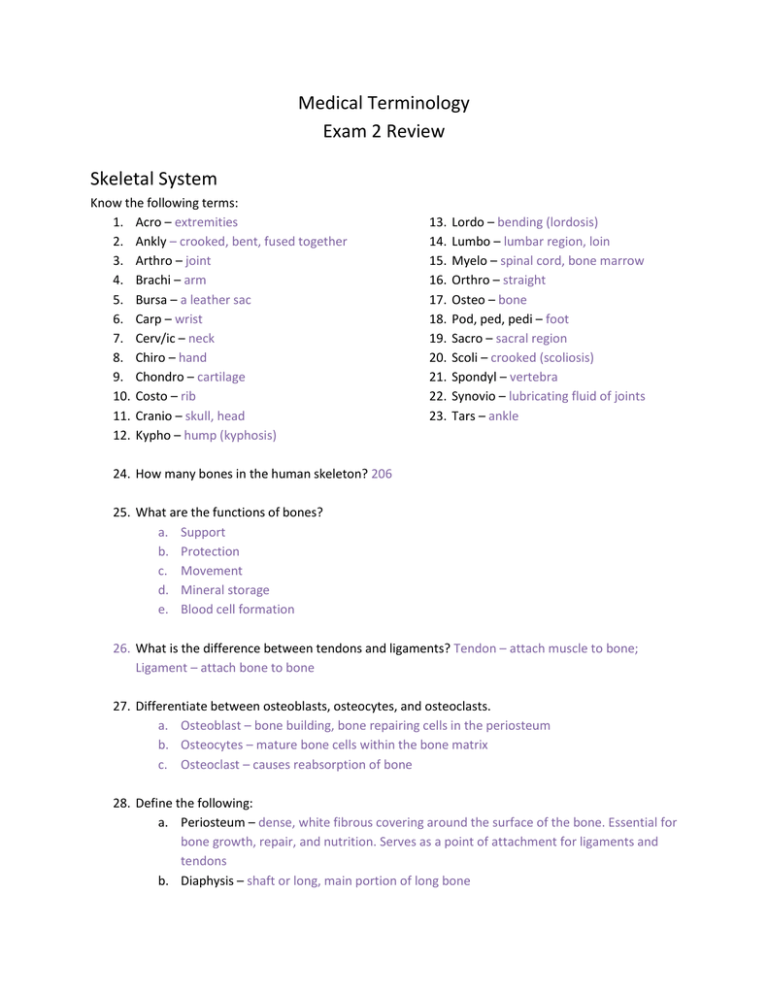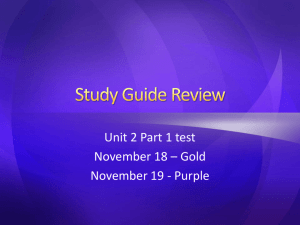Medical Terminology Exam 2 Review Skeletal System Know the
advertisement

Medical Terminology Exam 2 Review Skeletal System Know the following terms: 1. Acro – extremities 2. Ankly – crooked, bent, fused together 3. Arthro – joint 4. Brachi – arm 5. Bursa – a leather sac 6. Carp – wrist 7. Cerv/ic – neck 8. Chiro – hand 9. Chondro – cartilage 10. Costo – rib 11. Cranio – skull, head 12. Kypho – hump (kyphosis) 13. 14. 15. 16. 17. 18. 19. 20. 21. 22. 23. Lordo – bending (lordosis) Lumbo – lumbar region, loin Myelo – spinal cord, bone marrow Orthro – straight Osteo – bone Pod, ped, pedi – foot Sacro – sacral region Scoli – crooked (scoliosis) Spondyl – vertebra Synovio – lubricating fluid of joints Tars – ankle 24. How many bones in the human skeleton? 206 25. What are the functions of bones? a. Support b. Protection c. Movement d. Mineral storage e. Blood cell formation 26. What is the difference between tendons and ligaments? Tendon – attach muscle to bone; Ligament – attach bone to bone 27. Differentiate between osteoblasts, osteocytes, and osteoclasts. a. Osteoblast – bone building, bone repairing cells in the periosteum b. Osteocytes – mature bone cells within the bone matrix c. Osteoclast – causes reabsorption of bone 28. Define the following: a. Periosteum – dense, white fibrous covering around the surface of the bone. Essential for bone growth, repair, and nutrition. Serves as a point of attachment for ligaments and tendons b. Diaphysis – shaft or long, main portion of long bone c. d. e. f. 29. 30. 31. 32. 33. 34. 35. Epiphysis – expanded ends of long bone Red marrow – blood cell forming tissue in long bones Yellow marrow – fat storing tissues in long bones Articular cartilage – thin layer of cartilage covering the epiphysis in order to reduce friction during movement of the joint g. Endosteum – thin layer of squamous cells lining medullary cavity h. Long bone – Longer than it is wide (femur) i. Short bone – cube-shaped (tarsals) j. Flat bone – Generally thin and flat, provides protection and surface area for muscle attachment (scapula) k. Irregular bone – variously shaped bones (vertebrae) l. Foramen – opening or hole through bone serving as a passageway for nerves or blood vessels m. Meatus – tube-like passage way in a bone n. Sinus – the space within a bone, lined with a mucous membrane o. Fossa – fairly deep pit or depression p. Condyle – large rounded prominence that articulates with another bone q. Tuberosity – elevated, rounded usually roughened area on a bone; generally bigger than a tubercle and is used for muscle attachment r. Trochanter – very large, blunt process used for muscle attachment s. Tubercle – small rounded process used for muscle attachment t. Process – any projection from a surface of a bone used in muscle attachment u. Suture – immovable joint (skull bones) v. Fontanel – membrane-filled spaces between cranial bones (baby’s soft spot) What happens at the epiphyseal line of long bones? growth What are the purposes of bone markings? a. Join one bone to another b. Provide surface for attachment of muscles c. Create an opening for the passage of blood vessels and nerves d. Used as landmarks The hyoid bone is the only bone that has not attachment to another bone How many of each of the following vertebrae? a. Cervical - 7 b. Thoracic – 12 c. Lumbar – 5 d. Sacral – 5 (fused) e. Coccyx – 3-4 (fused) What are the atlas and axis? a. Atlas – C1 (first cervical vertebrae) – supports the head b. Axis – C2 (2nd vertebrae) – allows for rotation of the head What is the appendicular skeleton? Bones of the extremities and pelvic girdle What is the axial skeleton? Bones of the skull, thorax, and vertebral column 36. Differentiate between: a. Arthritis – inflammation of bones at the joints b. Bursitis – inflammation of the bursa (fluid filled sac or cavity) c. Osteoporosis – bones become softer and more brittle and more liable to fracture because of mineral loss d. Scoliosis – curve of the spine e. Spina bifida – congenital defect in which the vertebrae fail to unite at the midline Muscular System 37. Know the following terms: a. Myo – muscle b. Oblique – angled c. Fascio – fascia d. –lysis – breakdown e. Teno – tendon f. –plegia – paralysis g. Kinesio- movement h. Rectus – straight i. Tono – tone j. Transverse – crosswise k. Sphincter – ring-like l. –cele – swelling, hernia, tumor m. –trophy – growth or development n. Fibro – fiber, connective tissue o. Contractility – the ability to shorten forcibly p. Extensibility – the ability to be stretched q. Elasticity – the ability to resume resting length r. Excitability – the ability to receive and respond to a stimulus s. Automaticity – the ability of a muscle to contract without a nerve supply 38. What are the five properties of muscle tissue? a. Contractility b. Extensibility c. Elasticity d. Excitability e. Automaticity 39. What are the functions of the muscular system? a. Movement b. Posture maintenance c. Joint stimulation d. Heat generation e. Protection of some internal organs 40. What are the three types of muscle tissue and where are they found? Which muscle tissues are voluntary and which are involuntary? Which are striated? a. Cardiac – found in heart – striated – involuntary b. Visceral (smooth) – internal organs – nonstriated – involuntary c. Skeletal – attaches to bones – voluntary – striated 41. Differentiate the following terms: a. Tendon – strong, tough connective tissue cord; attaches muscle to bone b. Fascia – tough, sheet-like membrane that covers and protects tissues c. Aponeurosis – broad, flat sheet of connective tissue d. Raphe – seam of fibrous tissue 42. Define the following: a. Muscle fatigue – Muscle is unable to contract because of a deficit of ATP (energy) b. Spasm – sudden, involuntary contraction of a muscle c. Clonic – spasm alternating with relaxation d. Tonic – sustained e. Tetany – result of low calcium – loss of sensation, muscle twitching, convulsions 43. Which muscle is slower to contract? Visceral 44. Which muscle fiber has more mitochondria because it needs a constant supply of oxygen? Cardiac 45. Which muscle fiber has autorhythmicity? Cardiac 46. Differentiate between origin and insertion. a. Origin – muscle attachment at the end that does not move – usually proximal to insertion b. Insertion – muscle attachment to the end that moves when the muscle contracts 47. Define the following: a. Prime mover – Initiates movement, main mover b. Antagonist – opposes movement c. Synergist – assists in movement d. Fixator – stabilizes the bone or muscle origin 48. The following is true of muscle tone: a. Steady partial contraction is present at all times b. State of tension when awake c. Does not produce active movement 49. What is a contraction? Shortening of muscle due to sliding of myosin and actin filaments. All or nothing reaction. 50. Know the following directional terms: a. Flexion – decreasing the angle of a joint b. Extension – increasing the angle of a joint c. Hyperextension – increases the angle beyond anatomical position d. Dorsiflexion – move the sole of the foot upward (pointing toe to head) e. Plantar flexion – move the sole of the foot downward (point toes down) f. Adduction – moving a body part to midline g. Abduction – moving a body part away from midline h. Circumduction – the distal end of an extremity inscribes a circle while the shaft inscribes a cone (Ex: arms outstretched, move arm in big circles – see slides for picture) i. Rotation – revolving a body part along a longitudinal axis j. Supination – turn the palm upward (hold a bowl of soup) k. Pronation – turn the palm downward 51. Know the following nomenclature for muscles: a. Bi, tri, quad – 2, 3, 4 b. Externus – exterior c. Gracilis – slender d. Latissimus – wide e. Longissimus – long f. Longus – long g. Medius – interMEDiate h. Orbicularis – around i. Quadratus – square (FOUR sides) j. Rectus – straight k. Rhomboideus – diamond-shaped l. Scalenes – irregular triangle m. Teres – round n. Transverse – crosswise o. Vastus – great (vast)







